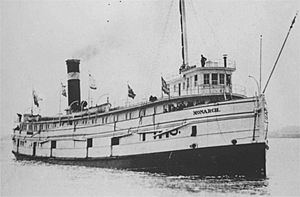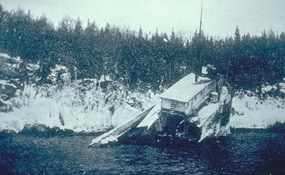SS Monarch facts for kids
class="infobox " style="float: right; clear: right; width: 315px; border-spacing: 2px; text-align: left; font-size: 90%;"
| colspan="2" style="text-align: center; font-size: 90%; line-height: 1.5em;" | 
|} The SS Monarch was a large ship built in 1890. It carried both people and goods across the Great Lakes. In 1906, the Monarch sank near Isle Royale in Lake Superior. Parts of the ship and its cargo are still at the bottom of the lake. In 1984, the wreck was added to the National Register of Historic Places. This means it is an important historical site.
History of the Monarch
The Monarch (Official Number 96843) was a wooden ship. It was built in 1890 in Sarnia, Ontario, Canada. John Dyble built it for the Northwest Transportation Company. The ship was launched on June 27, 1890. It was the last ship built in Sarnia for a long time.
The Monarch was 259 feet (78.9 meters) long. It was 35 feet (10.7 meters) wide and 15 feet (4.6 meters) deep. It had a powerful 900-horsepower (671-kilowatt) engine. This engine used steam and had two large boilers. The ship could travel at 14 miles per hour. The Monarch's body was made stronger with iron. It also had 65 cabins for passengers.
Throughout its time on the water, the Monarch carried both passengers and packages. It mainly traveled between Sarnia, Thunder Bay, Ontario, and Duluth, Minnesota. In 1899, the Northwest Transportation Company joined with another company. They formed the Northern Navigation Company, Ltd.
The Final Journey
On December 6, 1906, the Monarch was loaded with cargo. It had wheat, oats, salmon, and other goods. The ship left Thunder Bay to go to Sarnia. A very strong snowstorm was happening. For some reason, the ship went off its planned path.
That night, the Monarch crashed at full speed. It hit the rocky shore of Blake Point on Isle Royale. The ship's engineer kept the engine running. This helped to hold the ship in place against the shore. John D. McCallum, whose brother was the first mate, bravely carried a rope to the shore. He did this through the rough waves.
The crew and passengers used this rope to get off the sinking ship. Almost everyone was saved; only one person died. The survivors stayed on Isle Royale for four days. They found food from the wreck to eat. They also kept signal fires burning to get help. On December 10, 1906, they were finally rescued.
The night after their rescue, the wreck broke into two pieces. Only the front part of the ship could be seen. Over the next two years, people tried to save parts of the Monarch. In 1908, the engine and other machinery were successfully removed from the wreck.
The Wreck Today
Today, the wooden parts of the Monarch wreck have broken apart. However, many pieces of the ship can still be seen. Large parts of the wooden wreck are spread out on the bottom of Lake Superior. They are found at depths from 10 to 80 feet (3 to 24.4 meters).
There is also a lot of the Monarch's cargo still lying on the lake bottom. This cargo is near the wreck site. The Monarch wreck is a popular spot for divers. In 2009, about 85 dives were made to this wreck. This was out of 1,062 dives made to all wrecks in the Isle Royale National Park.
| History | |
|---|---|
| Name | Monarch |
| Operator | Northern Navigation Company, Ltd |
| Builder | John Dyble |
| Launched | June 27, 1890 |
| Fate | Wrecked 6 December 1906 |
| General characteristics | |
| Type | Passenger-package freighter |
| Length | 259 feet |
| Beam | 35 feet |
| Depth | 15 feet |
| Installed power | 900HP |
| Propulsion | triple expansion steam engine |
| Speed | 14 knots |
| Notes | Official Number 96843 |
|
MONARCH
|
|

Bow section of the Monarch
|
|
| Location | Palisade area, north side of Blake Point, Isle Royale National Park, Michigan |
| Area | 45.9 acres (18.6 ha) |
| Built | 1890 |
| Architect | John Dyble |
| Architectural style | Passenger-package freighter |
| MPS | Shipwrecks of Isle Royale National Park TR |
| NRHP reference No. | 84001779 |
| Added to NRHP | June 14, 1984 |



